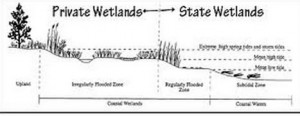The first thing that probably comes to mind about things that limit or stifle development of a marina site is government regulation. So why make it the fourth thing I’ve considered, not the first? That’s because many of the government regulations kick-in and branch based on what type of soils are there and whether wetlands are present.
 It’s definition time. “Tidal Wetlands” in Maryland are defined as follows (some other States have slightly different definitions, but they are similar):
It’s definition time. “Tidal Wetlands” in Maryland are defined as follows (some other States have slightly different definitions, but they are similar):
“all state and private tidal wetlands, marshes, submerged aquatic vegetation, lands, and open water affected by the daily and periodic rise and fall of the tide within the Chesapeake Bay and its tributaries, the coastal bays adjacent to Maryland’s coastal barrier islands, and the Atlantic Ocean to a distance of 3 miles offshore of the low water mark.
From the same source as the footnote above, “Nontidal wetlands” are areas meeting the following conditions:
“…an area that is inundated or saturated by surface water or ground water at a frequency and duration sufficient to support, and that under normal circumstances does support, a prevalence of vegetation typically adapted for life in saturated soil conditions, commonly known as hydrophytic vegetation.”
“Nontidal wetlands are commonly known as marshes, swamps, bogs, wet meadows and bottomland forests. They are inland, freshwater areas not subject to tidal influence and are usually covered or saturated with water for long periods during the growing season.”
“They are typically areas where the water table is at or near the surface, or the land is covered by shallow water.” (http://www.mde.state.md.us/assets/document/wetlandswaterways/values.pdf)
Sorry… had to get that stuff out of the way. Several things in the above are important.
- To develop in a tidal wetlands, you need a permit; however, it is extraordinarily difficult to get (read that as low probability). If you need a road through tidal wetlands, you’ll need to prove “hardship”. The terms “necessary” and “unavoidable” are also used, although again language can vary between states (but the intent remains the same). http://www.mde.state.md.us/assets/document/wetlandswaterways/property.pdf
- Non-tidal wetlands also require a permit but that too is difficult, although not as much so as tidal wetlands. The request is different, though, because it not just pertains to roads – this is also the area that owners and assessors count toward the land yield or the number of buildable lots you can get out of a property, sometimes calculated on a per acre basis.
- Non-tidal wetlands are still wetlands. They are not developable uplands to anywhere near the same degree as a site without them. The land yield is low compared to other sites in the same zoning that are not wetlands. Just because a site can be subdivided does not make it a subdivision in the typical sense.
- Maryland has a 25 foot buffer around all pockets of wetlands. If you have many discrete pockets, this could substantially affect your development yield (you cannot run roads or anything through the buffer areas).
So the next question is how much of a marina site is tidal wetlands, non-tidal wetlands and developable uplands? Without the services of an environmental scientist via a wetlands delineation, an appraiser, assessor or marina owner just cannot be sure. Yet in a tax appeal, both the appraiser and the assessor will have to make their best estimates. It’s the due diligence that will decide who is and who is not credible in this regard.
Although the above was based on Maryland regulations, the germane point is that the land yield you can get from a marina site also depends on how the property falls into the above three classifications. But it doesn’t end there… Part 5 will address a host of other governmental factors that affect marina land building potential.

